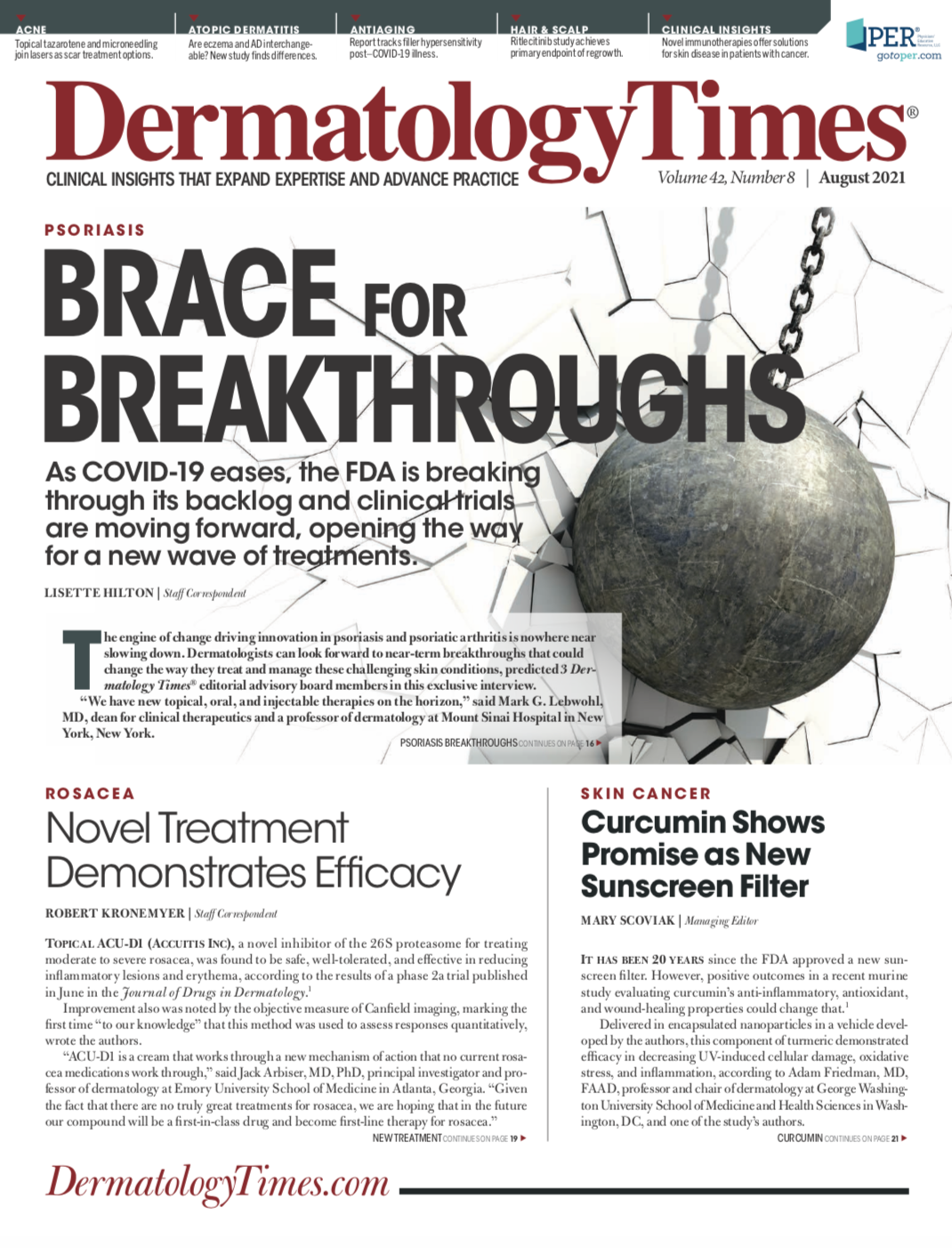- Case-Based Roundtable
- General Dermatology
- Eczema
- Chronic Hand Eczema
- Alopecia
- Aesthetics
- Vitiligo
- COVID-19
- Actinic Keratosis
- Precision Medicine and Biologics
- Rare Disease
- Wound Care
- Rosacea
- Psoriasis
- Psoriatic Arthritis
- Atopic Dermatitis
- Melasma
- NP and PA
- Skin Cancer
- Hidradenitis Suppurativa
- Drug Watch
- Pigmentary Disorders
- Acne
- Pediatric Dermatology
- Practice Management
- Prurigo Nodularis
- Buy-and-Bill
Publication
Article
Dermatology Times
Acne Scar Armamentarium Melds Proven and Emerging Treatments
Author(s):
Here are best practices in understanding scar morphology, building patient trust, and choosing treatment.
Patients with acne scars need to feel comfortable enough with their dermatologist to stay committed to a course of treatments and that means giving an explanation of scar morphology and etiology, as well as reviewing treatment options and timelines, said David Ozog, MD, FAAD, FACMS, in his presentation1 at American Academy of Dermatology Virtual Meeting Experience 2021, which was held in April.
Over the past 3 to 5 years, understanding of how acne scars form has increased dramatically. Results of a 2018 study2 showed that acne scars are characterized by B-cell infiltration and that longer-term inflammation results in the destruction of sebaceous glands. Another study’s results3 demonstrated that acne scarring is a systemic disease and that hepcidin and C-reactive protein levels are predictors for scarring. Results of a 2020 study4 found that circulating collagen III levels are a biomarker for postacne scarring and decrease after treatment.
Severity, time to treatment, gender, and whether acne is relapsing or recurrent all affect the risk of scarring. Steroid injections can be a cause, so Ozog, chair of the Department of Dermatology at Henry Ford Hospital in Detroit, Michigan, suggested being cognizant of staying superficial for injections and entering the needle through a pore or follicle.
Scar Types and Treatments
Topical tazarotene and microneedling have been shown to diminish acne scars.5 Results of a 2016 study6 of 16 laser devices show that CO2 and Er:YAG lasers were best suited for atrophic scars. Ablative fractional lasers may offer the best compromise between efficacy and adverse effects.
However, the study ignored one of the most popular emerging treatments: microneedling. Ozog noted that microneedling is now the most commonly used treatment for acne scars and that results are improved by adding a variety of other modalities, especially plasma-rich platelets. The combination of modalities also reduced erythema. He noted that microneedling can be used on large areas and with low risk of pigmentation issues in patients with skin of color.
In a 2017 split face study that compared Er:YAG lasers with microneedling7, results showed that the laser was slightly more effective but both had benefits. Ozog cautioned that IPL and PDL lasers remain the best option for hypertrophic or erythematous scars.
He detailed his preferred treatment approaches for various types of acne scarring. “The treatments for boxcar scars [is to] cut them out and try to smooth things out later or you can plane down those higher peaks or do something to stimulate collagen, but usually it’s a combination of things that helps…because they are so challenging,” Ozog said.
For ice pick scars, he favors the CROSS method of applying trichloroacetic acid (TCA) to the bottom of the scar.8 Ozog noted that there is no issue with postinflammatory hyperpigmentation when using this method as long as the dermatologist is careful to keep the TCA in the scar. Ozog also noted that he wants to try using an empty insulin syringe with a 31-gauge needle as used in a 2020 study9 to apply the TCA.
Rolling scars are easier to treat, according to Ozog. He uses the subcision method originally detailed in a 1995 study.10
“First you have to mark the areas to be treated with a sterile marker, then you confirm with the patient, make sure there’s no other areas, and you can do topical anesthetic with subcision if you need,” he said. “The technique itself is quite simple. [It’s] a topical anesthetic, and we’re going parallel to the skin surface. You can feel those fibrotic bands. It’s a back-and-forth piston type motion until you can freely sweep the 30-gauge 0.5-inch needle under there.”
For macular/erythematous scarring, Ozog prefers a pulsed dye laser.
Disclosure:
Ozog reported no disclosures relevant to the presentation.
References:
- Ozog D. Treatment of acne scarring. American Academy of Dermatology 2021 Virtual Meeting Experience (AAD VMX); April 23-25, 2021; virtual. Accessed April 30, 2021.
- Carlavan I, Bertino B, Rivier M, et al. Atrophic scar formation in patients with acne involves long‐acting immune responses with plasma cells and alteration of sebaceous glands. Br J Dermatol. 2018;179(4):906-917. doi:10.1111/bjd.16680
- El-Taweel AA, Salem RM, El-Shimi OS. Predictive value of serum markers for postacne scarring. J Cosmet Dermatol. 2018;17(3):491-494. doi:10.1111/jocd.12402
- Abdel-Magiud EM, Taha EA, Bakr RM, et al. Effects of different therapeutic modalities for postacne scars on circulating collagen III. J Cosmet Dermatol. 2020;19(6):1517-1521. doi:10.1111/jocd.13184
- Afra TP, Razmi TM, Narang T, Dogra S, Kumar A. Topical tazarotene gel, 0.1%, as a novel treatment approach for atrophic postacne scars: a randomized active-controlled clinical trial. JAMA Facial Plast Surg. 2019;21(2):125-132. doi:10.1001/jamafacial.2018.1404
- Cohen BE, Brauer JA, Geronemus RG. Acne scarring: a review of available therapeutic lasers. Lasers Surg Med. 2016;48(2):95-115. doi:10.1002/lsm.22410
- Osman MAR, Shokeir HA, Fawzy MM. Fractional erbium-doped yttrium aluminum garnet laser versus microneedling in treatment of atrophic acne scars: a randomized split-face clinical study. Dermatol Surg. 2017;43(suppl 1):S47-S56. doi:10.1097/DSS.0000000000000951
- Lee JB, Chung WG, Kwahck H, Lee KH. Focal treatment of acne scars with trichloroacetic acid: chemical reconstruction of skin scars method. Dermatol Surg. 2002;28(11):1017-1021. doi:10.1046/j.1524-4725.2002.02095.x
- Bahl A, O’Connor K, Chung HJ. Treatment of atrophic acne scars with combination therapy of chemical reconstruction of skin scars method and fractionated nonablative laser: a retrospective analysis. J Cosmet Dermatol. 2020;19(10):2591-2595. doi:10.1111/jocd.13514
- Orentreich DS, Orentreich N. Subcutaneous incisionless (subcision) surgery for the correction of depressed scars and wrinkles. Dermatol Surg. 1995;21(6):543-549. doi:10.1111/j.1524-4725.1995.tb00259.x






